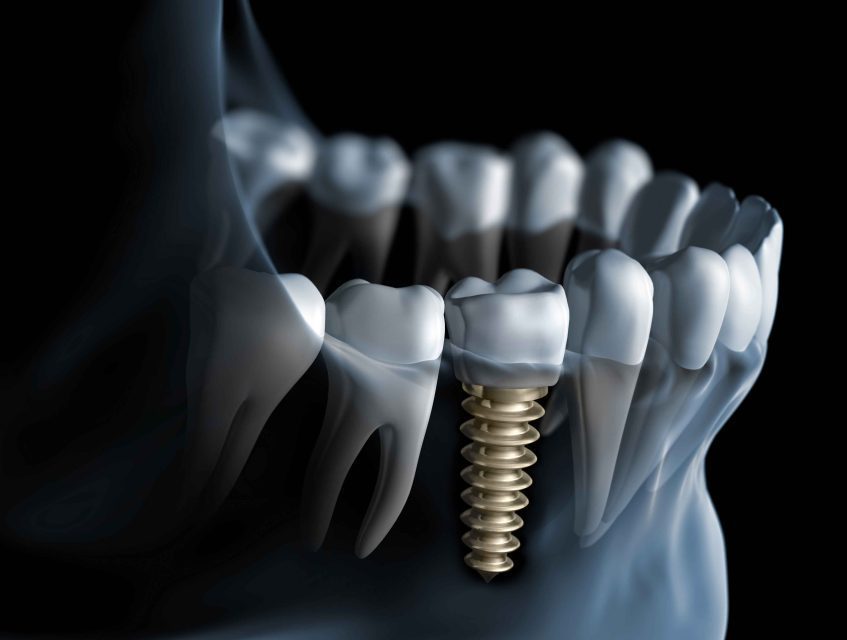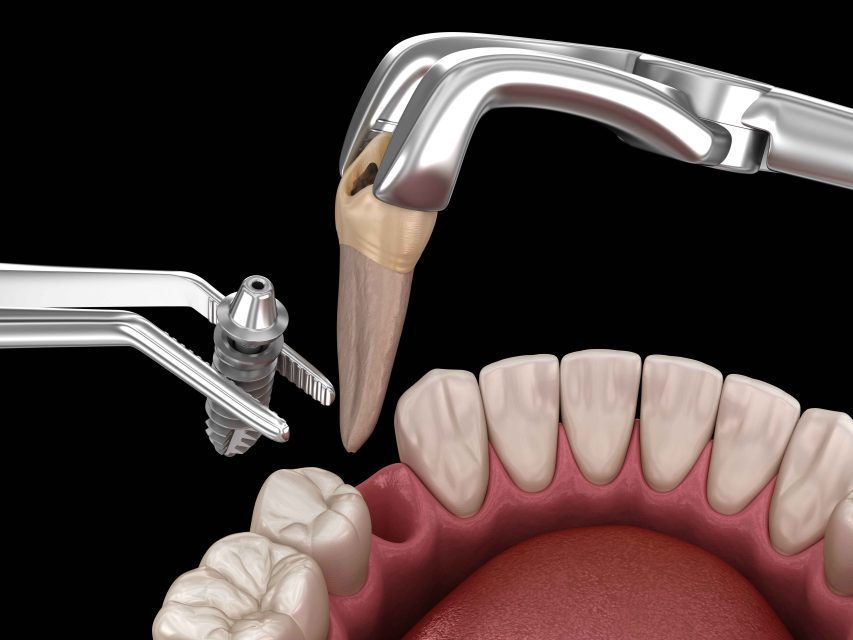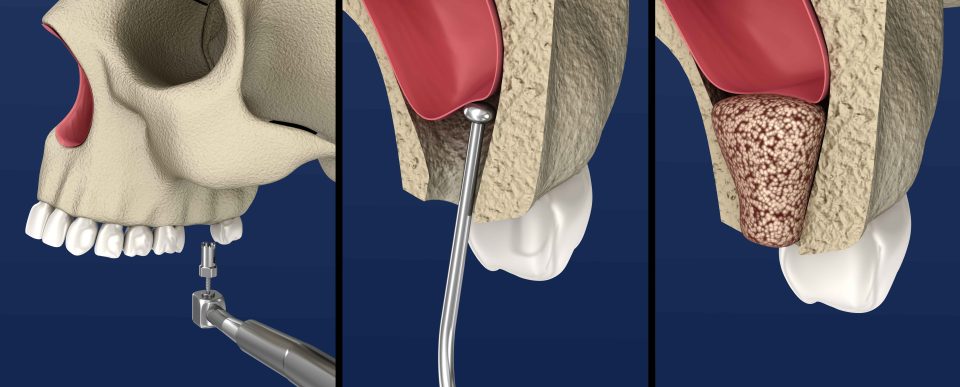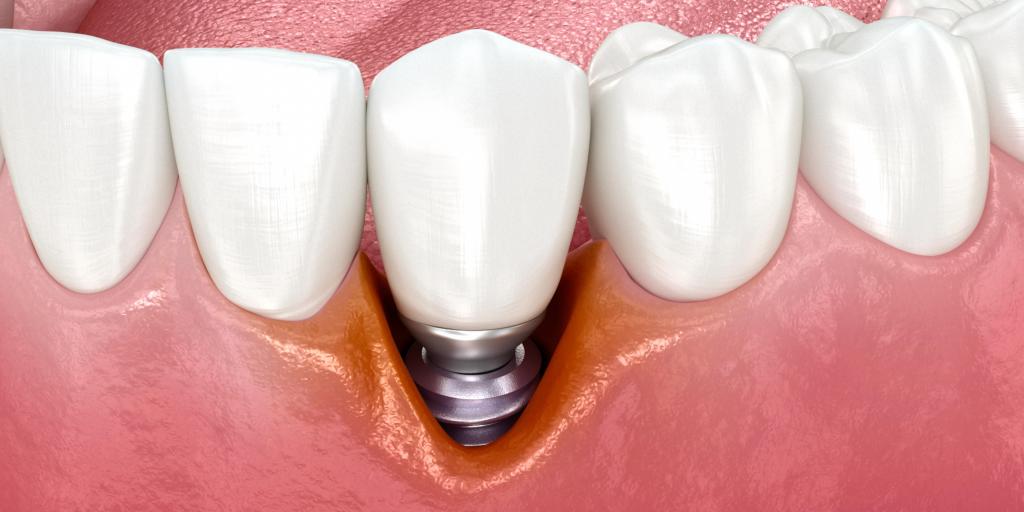
Implant Dental Treatments

Tooth deficiencies can greatly affect the comfort of life, so the first goal in dental treatments is always to keep the tooth in the mouth. Because even one tooth loss upsets the entire balance in the mouth and affects the survival of the remaining teeth. Implant teeth are treatment solutions that can best imitate the structure of natural teeth and restore the lost pleasure of eating and aesthetic smile.
Dental implants that will replace missing teeth are generally composed of titanium compounds. Titanium implants, which will serve as artificial tooth roots, are perfectly compatible with bone tissue and show high resistance to intraoral forces. Due to its high biocompatibility, titanium dental implants can be applied to previously lost tooth cavities as well as into the bone immediately after tooth extraction with immediate implant, that is, immediate placement protocol. The aim of dental implant treatment is not only to close the gaps, but also to regain comfortable chewing, comfortable speaking and aesthetic tooth appearance. When there is sufficient bone level, dental implants can be placed in a single session with simple interventions. If there is not enough bone level and density, it can be expected to reach the optimum level with bone powder applications. Fixed prostheses, removable prostheses or hybrid prostheses can be applied on dental implants placed in the jawbone. Contemporary solutions applied in the field of implant dental treatments in Nevşehir are described below.

Immediate Implant Teeth – Immediately Implant
The presence and function of our teeth have a great place in our social and business life. Therefore, the first thought is always to keep the teeth healthy in the mouth. However, dental implants will be the fastest and permanent solution for the recovery of teeth that are inevitable or that have been lost before.
In traditional implant applications, there was a need to wait for a long time after the teeth were extracted for the bone tissue to repair itself and to fill the gaps. Today, in modern dentistry, it is possible to immediately implant the implant, and if suitable conditions are provided, it is possible to insert the teeth immediately.
It may not be possible to place an implant immediately after tooth extraction, due to the lack of sufficient bone tissue or the possibility that the existing inflamed areas may adversely affect the implant and bone connection. Scientific studies focused on this subject have shown that success in implant placement is directly related to the correct diagnosis and correct treatment plan. Again, immediate loading, that is, the ability to apply fixed teeth immediately, depends on the strong stance of the implant in the first stage after it is placed in the bone. In short, scientific studies have shown that with correct diagnosis and correct treatment approaches, people with tooth loss can regain their teeth in a few days. In the treatment of missing teeth, the number of days without teeth is gradually decreasing and today, implant treatment is successfully applied in one day.
Immediate Fixed Tooth and Immediate Implant Tooth Applications Mostly Bring Solutions to the Following Situations;
- In the presence of a completely edentulous upper jaw, preferably 8 implants, 4-6 implants depending on the bone condition can be fixed immediately with a fixed tooth.
- In the presence of a completely edentulous lower jaw, preferably 6 implants can be placed immediately, depending on the bone condition, with 3-4 implants.
- Fixed teeth can be placed immediately after implant application in the absence of a single tooth in the lower jaw or upper jaw posterior regions.
- If more than one tooth is missing in the lower jaw or upper jaw posterior regions, fixed teeth can be placed immediately after at least 2 implants.
- Fixed teeth can be inserted immediately in the absence of aesthetic teeth in the anterior region. However, the contact of these teeth with the teeth in the opposite jaw should be removed.

All on Four Implant Teeth- All on 4 and All on 6
It is valuable to be able to produce solutions in a short time for people who have lost or have reached the level of losing all their teeth. Time is an invaluable blessing and no one wants to waste time on long-term treatment protocols. All on four or six treatment methods have provided a facilitating point of departure for the time problem in the field of dentistry. In this treatment method, fixed teeth can be applied immediately after the teeth are extracted or if the teeth have been previously extracted, the bone preparation is completed. This technique, which has been applied for more than 30 years, has been clinically proven to be successful.
When jaws that have been neglected for a long time for various reasons are examined, gum diseases, tooth root inflammation, bone resorption or anatomical changes may be encountered. In such cases, it becomes very difficult to provide treatment with traditional methods.
The number of implants needed varies according to bone levels and personal anatomical factors in jaws where all teeth have been lost.
In all on 4 or all on 6 six applications to the upper jaw;
- Composed of larger surfaces than the lower jaw
- The anterior region is important because it is the first noticeable area in the smile and is called the aesthetic region.
- The bone density is lower than the mandible, meaning the bone is more porous and therefore takes longer for the implants to fuse to the bone.
- There are sinus cavities in the posterior regions of the upper jaw that aid breathing, and the bone is generally shorter in these regions. For this reason, bone augmentation applications, angled implants or short implants may be preferred in this region.
- Due to all these anatomical reasons, in order to create a stable support structure in the upper jaw, an all on six i.e. 6 implant prosthesis is preferred.
During lower jaw all on 4 or all on 6 applications;
- Compared to the upper jaw, the bone consists of narrow and pointed surfaces.
- The bone density is higher than the upper jaw, so the implants hold on to the bone more tightly and the union rate is higher.
- Thanks to the strong support of the bone tissue, two implant in the each side of posterior region and 2 implants placed in the anterior region, that is, the all on four method applied on 4 implants in total is preferred.
In which cases all on four or all on six can be applied?
It can be applied to anyone who does not have any health problems that will prevent simple implant attempts, who has lost or will lose all their teeth in the near future, and who wants to have a tooth made immediately.
What are the Advantages of the All on Four or All on Six Method?
- There is no need to use long-lasting advanced surgical methods to eliminate bone deficiencies.
- The time spent without teeth is minimized, providing a solution without affecting work and social life.
- A solution is provided without being affected by the anatomical structures in the jaws.
- Since the teeth can be inserted immediately, it does not cause eating and drinking restrictions
- Does not cause speech difficulties as the teeth are attached immediately
Seamless Dental Implant
With the development of three-dimensional imaging technologies, it can be determined exactly where the implant will be placed in the bone with various diagnostic tools. With the combination of the experience of the practicing physician and the planning made on three-dimensional tomography, it is possible to place a seamless implant into the bone, since the need to cut the gum and separate it from the bone is reduced. Thanks to the seamless implant application, minimal trauma is experienced to the procedure area, the risk of post-procedure swelling and pain is reduced; In this way, the recovery period is more comfortable and faster.
Guided Implant Teeth – Guided Implant Teeth
In traditional methods, the area where the implant will be placed in the bone is determined visually during the procedure and is largely based on experience. Today, with the help of computer-assisted three-dimensional imaging techniques, the jaws can be evaluated in detail from every angle and the most suitable region for the implant can be determined with the help of guide programs. Thanks to computer-assisted guided implant applications, the margin of error in fixed dental prostheses to be made on implants is minimized and time can be saved.
Implant Dental Treatment in Weak Jaw Bones
The implant should be surrounded by at least 1,5-2 mm bone tissue from all sides for its initial stability and long-term survival at the time of placement. In addition to clinical examination, detailed analysis of the region with computer-assisted three-dimensional dental tomography is of great importance in order to examine the bone tissue in the region where the implant will be placed.
If insufficient bone tissue is detected in the implant area, new bone tissue can be formed for the lower and upper jaw by various methods. These methods are as follows;
- Sinus Lift – Sinus Surgery: The sinus cavities in the posterior region of the upper jaw usually cause the formation of thin bone tissues in this region. With the Sinus Lift technique, vertical improvements can be made to the bone tissue here.
- Ridge Split – Bone Spacer or Sandwich Technique: It is a technique in which the implant is placed between the bone pieces that are spaced in half in thin and vertically narrowing bone formations.
- Block Graft Technique: It is the technique of transferring the block bones taken from fertile bone areas such as the lower jaw corner or hip to the weak area.

Sinus Lift – Sinus lift or Sinus Surgery
Sinuses are air spaces in the upper back region of the upper jaw that are responsible for breathing. The sinuses, which are in close proximity to the upper molars, may hang down with the loss of these teeth, causing weakening of the surrounding bone tissue.
Sinus lifts can be done with open or closed method. In the closed technique, bone powder is added through the opening in the thin canal shape prepared for the implant. In the open technique, a window is opened to reach the implant site from the side and bone powder additions are made through this opening. If sufficient stability is provided, the implant can be placed in the same session, and in cases where the implant cannot be placed, bone tissue is expected to form for 6 months.
Sinus surgeries require high precision and are based on the experience of the physician. The aim is to strengthen the thinning bone tissue without damaging the sinus anatomy. Implant applications can be performed easily when sufficient bone tissue is provided in the area.
If there is little bone tissue around the sinus, short implants can be preferred or dental implants can be placed in the anterior and posterior neighborhoods of the sinus cavities thanks to angled implants. Although there are limited application areas, treatment solutions can be provided without the need for sinus surgery.
General Health Problems and Dental Implants
The holistic health of the person is the most important issue in dentistry practices. Oral and dental health is closely related to the diseases that concern the whole body. Lack of teeth and edentulism, as well as aesthetic problems, prevent healthy nutrition because foods cannot be grinded enough. In addition, deprivations in social and business life can cause psychological trauma. Therefore, physical and psychological health should be considered when planning implant treatments.
As with every treatment method, there are cases where dental implants cannot be applied. Conditions that should not be treated are called “Contraindications”. Contraindications are examined in two different classes as local and systemic. Local contraindications generally concern structures such as gingiva, bone tissue and soft tissues, and time-dependent solutions are available. Systemic contraindications, on the other hand, are related to general body diseases and affect implant applications in many respects.
IN THE SECTION BELOW, WE WILL EXPLAIN THE RELATIONSHIP OF SYSTEMIC DISEASES AND DENTISTRY, THE CONTENTS ARE PREPARED ON THE BASIS OF SCIENTIFIC ARTICLES AND CONTAINS MEDICAL TERMS. THE INFORMATION CONTAINED HEREIN IS FOR PRELIMINARY INFORMATION ONLY, THE FACTS ACCEPTED BY SCIENTIFIC AUTHORITIES VARY. PLEASE DO NOT CONDITION ABOUT YOUR EXISTING DISEASES AND DRUG USES WITHOUT CONTACTING YOUR DOCTOR!!
Heart and Vascular Diseases
Blood thinners, which are used extensively in cardiovascular diseases, should be questioned in detail before surgical procedures and a consultation should be made with the doctor who monitors the treatment. In cases such as high blood pressure, heart failure, atherosclerosis and coronary artery disease, the amount of oxygen carried in the blood decreases and the nutrition of the tissues is adversely affected. Despite these side effects, studies have not found any negative effects on the connection of dental implants to the bone, and they have been clinically successful. In addition, it has been proven that calcium channel blockers (Adalat, etc.) used in these diseases can slow down bone resorption as a result of their positive effects on calcium metabolism. It is estimated that these positive side effects also play a role in implant success.
Diabetes ( Diabetes Mellitus )
The most important findings of diabetes in the mouth are dry mouth, excessive caries, oral fungus and gum disorders. The most important side effect affecting implant treatments is delays in wound healing. Scientific research shows that the success rate of dental implant treatments in diabetic patients under control is no different from healthy people.
Before the procedure, it is essential to evaluate the results of blood analysis and, if necessary, to consult a competent doctor in this field. In order for dental implants to be successfully applied in diabetes, it is important to maintain blood-glucose values within normal limits for 2 months before and after the procedure.
Immune System Diseases and Corticosteroid (Cortisone) Use
Corticosteroids are miracle drugs that reduce inflammation and prevent inflammation-related swelling and pain. The most important side effects of corticosteroids, which are preferred in many systemic disorders due to their superior properties, are weakening the immune system and delaying wound healing. Considering these dose-dependent effects, the right treatment plan is determined by the physician. Antibiotic use is recommended after tooth extraction and implant procedures.
Bone Resorption (Osteoporosis)
It is a disease characterized by decreased new bone formation and weakening of bone tissue with increasing age. The osteoporosis seen in the jaws is not different from the other bones of the body. Adequate bone level before implant treatment is sufficient for the clinical success of the implant. In scientific studies, it has been shown that bone resorption has no effect on the long-term survival of the implant after the initial stability is achieved. In summary, bone resorption is not a complete contraindication in dental implant treatments. Despite this, it is essential to evaluate the oral and general body health in detail before the procedure.
Bisphosphonate Use
Bisphosphonates are often used against osteoporosis and bone tumor. However, it is among the drugs that are frequently preferred in most bone diseases. It suppresses the cells responsible for bone destruction and slows down bone resorption. Dental implants can be applied after evaluating the duration of use and doses of oral bisphosphonates. However, implant treatments are not recommended in patients receiving intravenous bisphosphonates.
Radiotherapy – Radiation Therapy
Radiotherapy applied to the head, neck and surrounding tissues reduces vascularity, slows down blood flow, less oxygen is carried in the blood and tissue healing is delayed. This increases the risk of osteoporosis. In patients receiving radiotherapy, the formation of the implant and bone connection may be delayed or even result in failure. Studies have shown that hyperbaric oxygen therapy prior to implant application increases the chance of success in patients undergoing radiotherapy. Radiotherapy application in the near future after implant treatment may lead to significant changes in the success rate.
Ectodermal Dysplasia
Ectodermal dysplasia mainly affects the skin, nails, hair and teeth. The typical intraoral appearance of this genetically transmitted disease is the absence of multiple teeth. In general, traditional prosthesis methods are insufficient in oral treatments due to small and narrow bone structures. Permanent and correct treatment method is dental implants.
Implant Dentures
The main goal of implant treatment is to regain the life comfort, functional features and aesthetic appearance that people lost with their teeth. To be used in these tasks, prostheses produced specially for the person with the support of the implants are called implant prostheses.
Fixed Implant Dentures
They are prostheses applied by sticking (cemented) or screwing on implants. They cannot be removed by the patient. Metal supported porcelain, zirconium porcelain, monolithic zirconium and durable composite materials can be preferred as infrastructure material. For cemented fixed prostheses, at least 6 implants are required in one chin, and for screwed fixed prostheses, at least 4 implants are required in one chin.
Removable Implant Dentures
These are prostheses that have parts that support both the palate and the implant and can be removed by the patient. It is especially preferred in cases where sufficient number of implants cannot be obtained or in cases where cleaning is difficult around the implant.

Periimplantitis
Periimplantitis is inflammation of the bone surrounding the implant. It is most commonly encountered in situations of inadequate oral care and poor hygiene. Loss of bone tissue due to inflammation may occur and this may cause the failure of the implant.
Treatment methods vary according to the level of inflammation. The main purpose is to remove the inflamed tissue. In initial periimplantitis cases, a deep cleaning without lifting the gingiva may be sufficient. In cases of advanced inflammation, detailed attempts should be made to regenerate the bone tissue around the implant by removing the gingiva.

